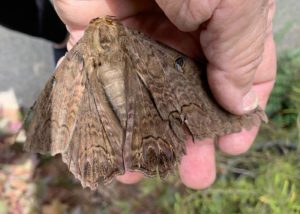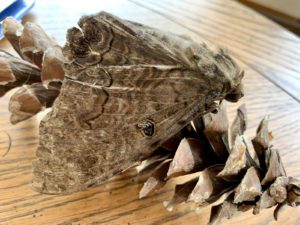Howdy, BugFans,
BugFan Marjie sent some “what-is-it?” pictures recently, of a lunker moth perched on one of her outbuildings. The BugLady didn’t need to hit the books to ID this one, it’s been on her “Most Wanted” list ever since she saw its picture in Holland’s The Moth Book when she was a kid, the better part of seven decades ago.
Black Witch moths (Ascalapha odorata) are members of the moth family Erebidae (Erebus is Greek for “from the darkness.”). They were formerly with the family Noctuidae, and they are the only members of their genus. In all the references that the BugLady looked at – and there are many, because along with the photo site hits, local newspapers often pick up the story when a Black Witch moth comes to town – she didn’t find any explanation of the species name odorata, which is Latin for “scented, having an odor.”
Marjie’s moth was pretty worn out, which is not surprising considering how far it was from home. Its normal range is northern South America, Central America, Mexico, and the Caribbean, but it migrates/strays both north and south from there. Black Witch moths have been found throughout North America as far north as Alaska, Churchill, and Newfoundland, and in South America as far south as Argentina, and they have traveled to Bermuda and Africa.

There are breeding populations in Los Angeles, Hawaii, and in far-southern Texas and Florida. Scioto County, in southern Ohio, is their northernmost “breeding record” – a newly emerged moth was found there, but whether it was the result of “boy meets girl” or of an already-gravid female winging her way to Ohio is unknown.
With a wingspan of five to seven inches and a more aerodynamic design than similarly sized Giant silk moths like the Cecropia and the Luna, Black Witch moths are strong flyers that are often described as bat-like. They fly at night, high and fast, and minor obstacles like the Gulf of Mexico don’t deter them – they are regulars on ships and off-shore oil rigs. According to one source, a Black Witch moth can fly from the Rio Grande to Maine in three weeks.
They tend to migrate during Mexico’s rainy season, from mid-summer until early fall, and according to PJ Liesch at the UW Madison Department of Entomology’s Insect Diagnostic Lab, Wisconsin’s annual records often follow a hurricane or a fluctuation of the jet stream, and 2021 has already seen more records than usual. Writing on the website Texas Entomology, Mike Quinn says that an observer “reported seeing hundreds of Black Witches within the eye of Hurricane Claudette when it made landfall along the middle Texas coast at Port O’Connor on July 15, 2003. While [he] observed none before the hurricane, hundreds, perhaps thousands were reported in and around Port O’Connor by many observers immediately after the storm passed.”
Adult females have a lacy-looking line running diagonally across the upper side of their wings, and both males and females have eyespots https://bugguide.net/node/view/664388/bgimage https://bugguide.net/node/view/1307361/bgimage, and males https://bugguide.net/node/view/663495/bgimage.
Black Witch caterpillars https://bugguide.net/node/view/1705558/bgimage are not super-picky food specialists; they feed nocturnally on the leaves of a number of genera of trees and shrubs in the pea/legume family, especially Acacias, and including Kentucky coffee tree and locust, and they hide in bark crevices by day. Adults nectar at flowers and sip tree sap, and they will come to the standard moth bait – a mixture of fermented fruit and beer, spread on a tree trunk. Bats, spiders, small rodents and a few species of birds eat them; one observer watched an ambitious Purple Martin feeding one to its nestling.
So, what’s in it for animals that undertake such extreme migrations – migrations that take them far from their caterpillar host plants and from potential mates? This kind of journey offers an opportunity for a species with the strength and the wanderlust to expand its range if it does happen upon favorable habitat. With Climate Change, suitable habitat for these moths may shift northward, but it’s unlikely that, all other things being equal, the Black Witch caterpillar or pupa could ever survive a northern winter. For most of the migrants, it’s a dead end.

BLACK WITCH MOTH – THE LEGEND
Mike Quinn calls it “the largest moth, if not the largest insect, north of Mexico,” so it’s not surprising that it has collected many names and that it has a place in the folklore of its homelands. It is variously associated with death (“mariposa de la muerte,”), restless souls, bad luck, good luck (especially with money), baldness, and blindness. In Hawaii, it is said to be the soul of someone recently dead, coming say good-bye.
Like Marjie’s moth, a good many Black Witch sightings are of moths sheltering during the day on (or even in) buildings, carports, or under eaves. The Mayan name for the Black Witch is X-mahan-nah, which means “House-borrower,” or “Habit of borrowing houses,” or “May I borrow your house?”
For more information, see http://jimmccormac.blogspot.com/2012/10/black-witch-spawned-in-ohio.html and http://texasento.net/witch.htm.
Thanks, Marjie. Wow!!
And when the BugLady says “Go outside, look at bugs,” remember that you could be lucky enough to find one of these giant moths.
The BugLady
Bug of the Week archives:
http://uwm.edu/field-station/category/bug-of-the-week/
